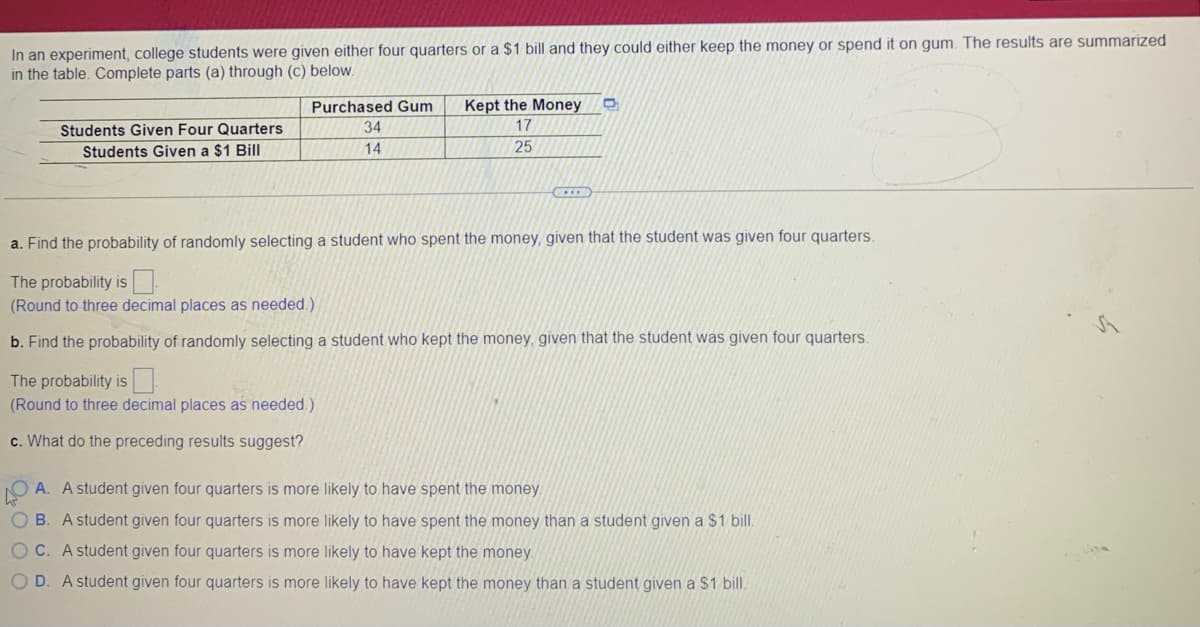In an experiment, college students were given either four quarters or a $1 bill and they could either keep the money or spend it on gum. The results are summarized in the table. Complete parts (a) through (c) below. Kept the Money 17 Purchased Gum Students Given Four Quarters Students Given a $1 Bill 34 14 25 a. Find the probability of randomly selecting a student who spent the money, given that the student was given four quarters. The probability is (Round to three decimal places as needed.) b. Find the probability of randomly selecting a student who kept the money, given that the student was given four quarters. The probability is (Round to three decimal places as needed.) c. What do the preceding results suggest? A. A student given four quarters is more likely to have spent the money. O B. A student given four quarters is more likely to have spent the money than a student given a $1 bil. OC. A student given four quarters is more likely to have kept the money. O D. A student given four quarters is more likely to have kept the money than a student given a $1 bill.
In an experiment, college students were given either four quarters or a $1 bill and they could either keep the money or spend it on gum. The results are summarized in the table. Complete parts (a) through (c) below. Kept the Money 17 Purchased Gum Students Given Four Quarters Students Given a $1 Bill 34 14 25 a. Find the probability of randomly selecting a student who spent the money, given that the student was given four quarters. The probability is (Round to three decimal places as needed.) b. Find the probability of randomly selecting a student who kept the money, given that the student was given four quarters. The probability is (Round to three decimal places as needed.) c. What do the preceding results suggest? A. A student given four quarters is more likely to have spent the money. O B. A student given four quarters is more likely to have spent the money than a student given a $1 bil. OC. A student given four quarters is more likely to have kept the money. O D. A student given four quarters is more likely to have kept the money than a student given a $1 bill.
Chapter8: Sequences, Series,and Probability
Section: Chapter Questions
Problem 41CT: On a game show, a contestant is given the digits 3, 4, and 5 to arrange in the proper order to form...
Related questions
Question

Transcribed Image Text:In an experiment, college students were given either four quarters or a $1 bill and they could either keep the money or spend it on gum. The results are summarized
in the table. Complete parts (a) through (c) below.
Purchased Gum
Kept the Money
Students Given Four Quarters
34
17
Students Given a $1 Bill
14
25
a. Find the probability of randomly selecting a student who spent the money, given that the student was given four quarters.
The probability is
(Round to three decimal places as needed.)
b. Find the probability of randomly selecting a student who kept the money, given that the student was given four quarters
The probability is
(Round to three decimal places as needed.)
c. What do the preceding results suggest?
A. A student given four quarters is more likely to have spent the money.
O B. A student given four quarters is more likely to have spent the money than a student given a $1 bill.
OC. A student given four quarters is more likely to have kept the money
OD. A student given four quarters is more likely to have kept the money than a student given a $1 bill,
Expert Solution
This question has been solved!
Explore an expertly crafted, step-by-step solution for a thorough understanding of key concepts.
Step by step
Solved in 2 steps with 2 images

Recommended textbooks for you


College Algebra (MindTap Course List)
Algebra
ISBN:
9781305652231
Author:
R. David Gustafson, Jeff Hughes
Publisher:
Cengage Learning


College Algebra (MindTap Course List)
Algebra
ISBN:
9781305652231
Author:
R. David Gustafson, Jeff Hughes
Publisher:
Cengage Learning